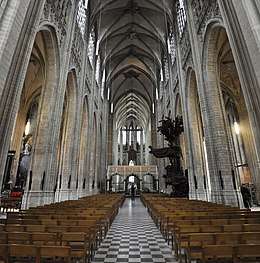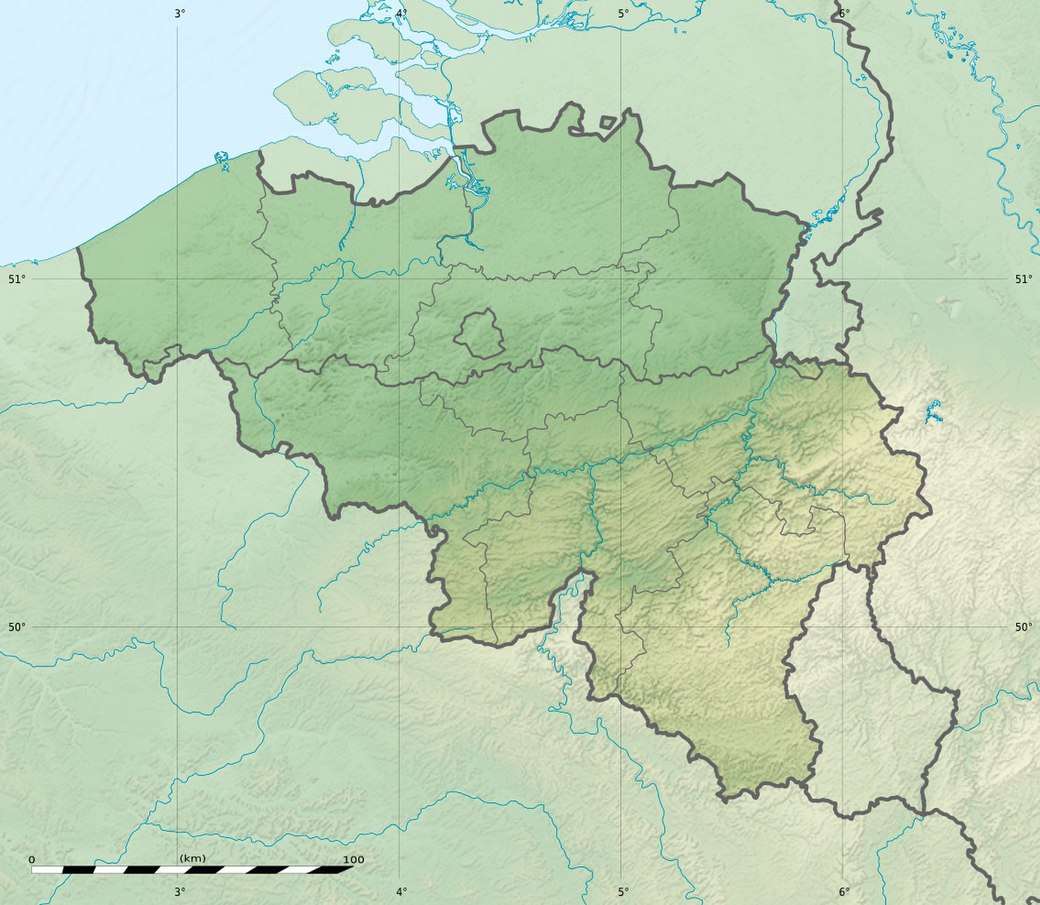St. Peter's Church, Leuven
Saint Peter's Church (Dutch: Sint-Pieterskerk) in Leuven, Belgium, is on the city's Grote Markt (market square), opposite the ornate Town Hall. Built mainly in the 15th century in Brabantine Gothic style, the church has a cruciform floor plan and a low bell tower that has never been completed. It is 93 metres (305 ft) long.
| UNESCO World Heritage Site | |
|---|---|
 | |
| Official name | Sint-Pieterskerk / Belfort |
| Location | Leuven, Belgium |
| Part of | Belfries of Belgium and France |
| Reference | 943bis-012 |
| Inscription | 1999 (23rd session) |
| Extensions | 2005 |
| Area | 0.255 ha (0.63 acres) |
| Buffer zone | 700 ha (1,700 acres) |
| Coordinates | 50°52′46″N 4°42′05″E |
 Location of St. Peter's Church, Leuven in Belgium | |
.jpg)
History
The first church on the site, made of wood and presumably founded in 986, burned down in 1176.[1] It was replaced by a Romanesque church, made of stone, featuring a West End flanked by two round towers like at Our Lady's Basilica in Maastricht. Of the Romanesque building only part of the crypt remains, underneath the chancel of the actual church.
Construction of the present Gothic edifice, significantly larger than its predecessor, was begun approximately in 1425, and was continued for more than half a century in a remarkably uniform style, replacing the older church progressively from east (chancel) to west. Its construction period overlapped with that of the Town Hall across the Markt, and in the earlier decades of construction shared the same succession of architects as its civic neighbor: Sulpitius van Vorst to start with, followed by Jan II Keldermans and later on Matheus de Layens. In 1497 the building was practically complete,[1] although modifications, especially at the West End, continued.
Towers

In 1458, a fire struck the old Romanesque towers that still flanked the West End of the uncompleted building. The first arrangements for a new tower complex followed quickly, but were never realized. Then, in 1505, Joost Matsys (brother of painter Quentin Matsys) forged an ambitious plan to erect three colossal towers of freestone surmounted by openwork spires, which would have had a grand effect, as the central spire would rise up to about 170 m,[2] making it the world's tallest structure at the time. Insufficient ground stability and funds proved this plan impracticable, as the central tower reached less than a third of its intended height before the project was abandoned in 1541. After the height was further reduced by partial collapses from 1570 to 1604, the main tower now rises barely above the church roof; at its sides are mere stubs. The architect had, however, made a maquette of the original design, which is preserved in the southern transept.
Despite their incomplete status, the towers are mentioned on the UNESCO World Heritage List, as part of the Belfries of Belgium and France.
War and after war
The church suffered severe damage in both World Wars. In 1914 a fire caused the collapse of the roof and in 1944 a bomb destroyed part of the northern side.
The reconstructed roof is surmounted at the crossing by a flèche, which, unlike the 18th-century cupola that preceded it, blends stylistically with the rest of the church.
A very late (1998) addition is the jacquemart, or golden automaton, which periodically rings a bell near the clock on the gable of the southern transept, above the main southern entrance door.
Artworks and relics
Despite the devastation during the World Wars, the church remains rich in works of art. The chancel and ambulatory were turned into a museum in 1998, where visitors can view a collection of sculptures, paintings and metalwork.
The church has two paintings by the great Flemish painter Dirk Bouts on display, the Last Supper (1464-1468) and The Martyrdom of St Erasmus (1465). The Nazis seized The Last Supper in 1942.[3] Panels from the painting had been sold legitimately to German museums in the 1800s, and Germany was forced to return all the panels as part of the required reparations of the Versailles Treaty after World War I.[3]
Exterior
- Unfinished tower
- Choir & ridge
 Transepts
Transepts- Gothic windows
Interior/General
In side chapels are the tombs of Duke Henry I of Brabant (d. 1235), his wife Matilda (d. 1211) and their daughter Marie (d. 1260). Godfrey II of Leuven is also buried in the church.
An elaborate stone tabernacle (1450), in the form of a hexagonal tower, soars amidst a bunch of crocketed pinnacles to a height of 12.5 metres (41 ft). A creation of the architect de Layens (1450), it is an example of what is called in Dutch a sacramentstoren, or in German a Sakramentshaus, on which artists lavished more pains than on almost any other artwork.
- Priest choir
- Tombe Henry I
- Sacrament Tower
- Rood screen
Interior/Church furnishings
A large and elaborate oak pulpit, which is transferred from the abbey church of Ninove, is carved with a life-size representation of Norbert of Xanten falling from a horse.
- Baroque pulpit
- Detail pulpit
- Choir stalls
- Detail 'misericorde'
Statues
There is also Nicolaas de Bruyne's 1442 sculpture of the Madonna and Child enthroned on the seat of wisdom (Sedes Sapientiae). The theme is still used today as the emblem of Katholieke Universiteit Leuven. One of the oldest objects in the art collection is a 12th-century wooden head, being the only remainder of a crucifix burnt in World War I.
- Sedes Sapientiae
- Anna te Drieën
- Christ
- Saint Peter
Paintings
The Last Supper, painted by Dirk Bouts between 1464 en 1468, is an absolute masterpiece. Until September 2018, the painting could be found in the M-Treasury of Saint Peter (a department of the municipal M-Museum Leuven). The Saint Peter's Church will reopen in September 2019 with a new visitors experience and the painting will be placed in its original location again. The street leading towards the West End of the church is named after the artist.
Other masterpieces in the church are The Martyrdom of Saint Erasmus from the same painter and the Edelheere Altarpiece (Descent from the cross) from Rogier van der Weyden.
 The Last Supper, Dirk Bouts
The Last Supper, Dirk Bouts_-_WGA03004.jpg) The Last Supper, Dirk Bouts (detail)
The Last Supper, Dirk Bouts (detail)_-_WGA02983.jpg) The Martyrdom of Saint Erasmus, Dirk Bouts
The Martyrdom of Saint Erasmus, Dirk Bouts Edelheere Altarpiece, Rogier van der Weyden
Edelheere Altarpiece, Rogier van der Weyden
The Twelve Highlights
At the reopening of St. Peter's Church in 2020, the focus will be on twelve highlights:
- Model of the West Towers
- The tomb of Duke Henry I of Brabant
- Head of Christ from the ‘Crooked’ or ‘Brown Cross’
- Edelheere Altarpiece (Descent from the cross) in imitation of Rogier van der Weyden
- The preserved works of Jan Rombouts, namely The Martyrdom of St. Clement and The Martyrdom of St. Catherine
- The chapel of Marguerite la Fière
- Triptych of the Last Supper from Dirk Bouts
- Triptych of the Martyrdom of St Erasmus from Dirk Bouts
- The Sacrament Tower by Lathieu de Layens
- The Triumphal Cross by Jan Borman de Oude
- The Sedes Sapientiae
- Chapel of the Brewers’ Guild
References
- The Great Market Square, Leuven city website (archived 4 December 2008)
- (in Dutch) 550 jaar Stadhuis Leuven Archived 2007-05-27 at the Wayback Machine
- Kurtz, Michael J. (2006). America and the return of Nazi contraband. Cambridge University Press. p. 30.
External links
- 'The Last Supper' in the Saint Peter's Church
- Services at Kerknet.be (only in Dutch)